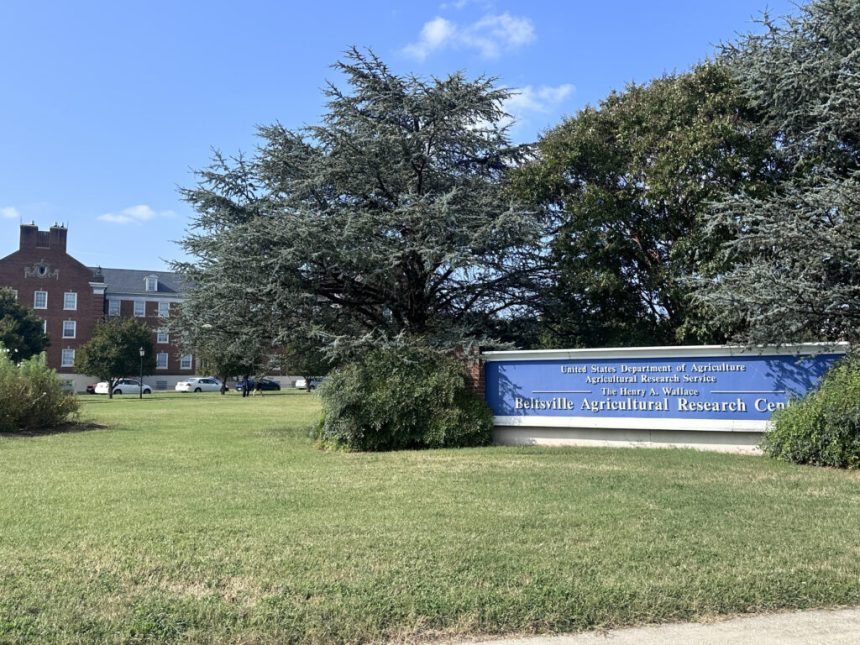The Beltsville Agricultural Research Center sprawls over 6,500 acres in northern Prince George’s County. The Trump administration has proposed closing it in the coming years. (Photo by Danielle J. Brown/Maryland Matters)
State, local and federal Democrats continued to push back Monday against a Trump administration proposal to shutter the Beltsville Agriculture Research Center and scatter its staff across the country, saying the center should stay at its current Prince George’s County home.
The lawmakers gathered Monday at the Beltsville center to highlight some of the research conducted there and argue that the current location is ideal for such studies.
“We call Maryland ‘America in Miniature.’ This BARC Ag facility is able to test many different types of crops on many different kinds of climate conditions,” Sen. Chris Van Hollen (D-Md.) told reporters Monday. “They’ve been doing studies, some have gone on for over 10 years, on the land here at BARC. You can’t just uproot that and take it to another part of the country.”
The news conference is the latest attempt by Maryland Democrats to counter a U.S. Department of Agriculture “reorganization” plan that the administration says will “achieve improved effectiveness and accountability, enhanced services, reduced bureaucracy and cost savings for the American people.”
Agriculture Secretary Brooke Rollins said in a memo announcing the changes in July that several USDA agencies in and around Washington, D.C., would be moved to other parts of the country to be “located closer to the people it serves while achieving savings to the American taxpayer.”
Maryland Democrats push back on USDA’s “reorganization” plan that would shutter the Beltsville Agricultural Research Center. (Photo by Danielle J. Brown/Maryland Matters)
Part of that plan calls for closing the 6,500-acre Beltsville center. The plan also calls for moving thousands of the USDA workers based in and around Washington to one of five regional hubs to reduce salary costs. Closing the Beltsville center would occur “over multiple years to avoid disruption of critical USDA research activities,” according to Rollins’ memo.
But Van Hollen and his colleagues — Sen. Angela Alsobrooks (D-Md.) and Reps. Steny Hoyer (D-5th), Glenn Ivey (D-4th) and Jamie Raskin (D-8th) — argued Monday that the loss of the Beltsville center could disrupt decades of research and even be more costly in the long run. Rep. April McClain Delaney (D-6th) also attended but had to leave before the news conference.
The press conference was held outside the USDAs National Agricultural Library, across U.S. Route 1 from the Beltsville research center. After a tour of the research center, the lawmakers acknowledged that 115-year-old facility needs repairs, but insisted that moving locations would be more expensive than investing in the center where it is.
Ivey called the USDA’s plan “terrible stewardship of the American tax dollar” and said moving the facility would waste millions on recent upgrades and repairs that have already been made to the Beltsville facility.
“There’s been a multimillion-dollar investment in this space, and if you just pick it up and move it, you’re squandering that money,” Ivey said. “It’s expensive to move, and you’d have to build new facilities wherever you go. And you’re going to lose the human capital.”
Also in attendance were Prince George’s County Executive Aisha Braveboy (D), County Councilmember Thomas E. Dernoga (D), state Sen. Jim Rosapepe (D-Prince George’s) and Del. Joseline Peña-Melnyk (D-Prince George’s and Anne Arundel).
Van Hollen highlighted the many agricultural research breakthroughs that have come from the Beltsville facility, from crop disease resistance to a recent development on the causes of bee colony collapse.
“Grass seed that you use in your backyard. The mosquito repellent you put on when you go for a hike. Roma tomatoes. Turkeys that you eat at Thanksgiving,” Van Hollen said. “Those are all brought to you by research here at BARC – and that’s just here on the consumer side. For farmers, it is especially important that BARC continue to do it’s work.”
Alsobrooks said that moving the facility and its workers would be illegal without congressional approval and would likely disrupt long-term research programs.
“Decades upon decades of important research literally would not survive the move and would be lost,” she said.
Losing the Beltsville facility would be just the latest blow to Prince George’s County by the federal government.
In January, the Bureau of Engraving and Printing announced that it was canceling plans to move its printing operations from its current plant in Washington to a new facility planned for ag center property in Beltsville, a move that would have brought about 1,400 jobs to the county. And in July, the FBI reversed more than a decade of study and planning and said it would not be building its new headquarters in Greenbelt, but would remain downtown instead in new quarters in the Ronald Reagan Building.
Hoyer argued that keeping BARC in Maryland is “not about politics,” but rather about “rationally organizing our agricultural community so that they can succeed and be the best at what they do in the world.”
“It’s a big campus – it is mostly ground and trees and vegetables and livestock,” he said. “There are buildings here as well, some that need repair – but what doesn’t need repair are the people who work here. It’s not the brick and mortar. It’s the people, the extraordinary talent that has been aggregated here.”
SUBSCRIBE: GET THE MORNING HEADLINES DELIVERED TO YOUR INBOX









